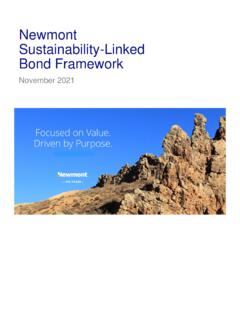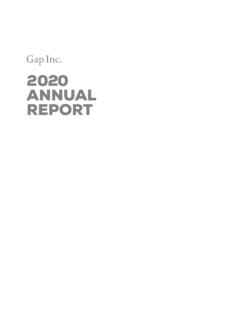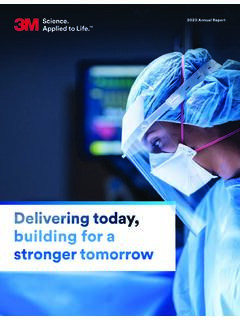Transcription of Shareholder Letter
1 Shareholder LetterQ3 2021 2 Dear Shareholders,Let's begin with the most exciting news - Lemonade Car was launched last week, and today, as part of our continued investment in our car business, we announce the acquisition of Metromile. While we have been at the forefront of using big data and AI in home and pet insurance, Metromile has been trailblazing a parallel path for car insurance. Metromile s car-mounted precision sensors took over 400 million road trips, covering billions of miles and sending real-time data streams to the Metromile cloud. These were mapped onto behaviors (how much someone drives, when, where, and how) and cross referenced with actual claims data, yielding precise predictions for losses per mile driven. These algorithms hold the promise of propelling Lemonade Car from a newcomer in the car insurance space to its vanguard. We believe today s deal will be a significant value unlock for our shareholders and customers, and expect this transaction to pay dividends in three important currencies: collapsing time, flattening risk, and increasing efficiency.
2 You can read more about our strategic rationale for pursuing this transaction in a blog post from our co-CEO, Daniel Schreiber, or in the investor presentation that accompanies this Lemonade Car was a Herculean effort by our team - the result is a car insurance product built from scratch in 2021 by the largest team we've ever assigned to a single project. You can read more about our product in a blog post from our co-CEO, Shai Wininger, and we're incredibly proud of what we have built. We also believe that as a result of the Metromile acquisition, things will only get better from here. We expect that injecting all the Metromile capabilities into Lemonade Car will lead to a product offering that stands alone in the market: we'll have all the people and tools in place to deliver the most seamless and customer-centric car insurance product, that is also the most affordable, precise, and fair. That's our with these significant developments in our car product and strategy, across the rest of our book of business, an overarching theme of 2021 happily sustained through Q3: we leaned in and sequentially ramped up our investment in growth.
3 We saw robust IFP growth in Q3, with IFP increasing by 84% year-over-year. We concluded Q3 21 with IFP of $347 million, and about million customers. We'd like to highlight a few key trends that are forming across the , Business Mix & BundlingIn Q3 21, we drove a record $50 million sequential increase in IFP. This marks the third consecutive record quarter and was a direct result of leaning in: a sequential increase in advertising investment in the period. Across our book of business, we are seeing trends that enhance customer lifetime value - most notably, the increasing prevalence of bundling and improving loss ratios in our newer business lines - and this gives us confidence to accelerate our investment pace. Additionally, Q3 is typically the quarter where we see tailwinds driven by seasonality in renter moving behavior. We capitalized on this effectively, delivering a record volume of gross new renters business in the period - thisreflected a sequential increase > 25% relative to Q2 renters growth remains healthy, consistent with our sustained strategy to diversify the book so long as unit economics are attractive, we actually drove faster YoY growth rates in each of our non-renters lines of business.
4 As a result, the business mix evolution we highlighted in detail last quarter has sustained, with non-renters' share of our overall book of business ticking up to 47% from 44% last quarter. Our pet line of business added 2% to its share, now up to 15%, life's share has increased to 2%, and homeowners' share is stable at 30%. 4As always, looking forward, our growth investment strategy will continue to allocate dollars primarily to the areas of our business that demonstrate the most healthy unit economics. In last quarter's Letter , we touched on the formation of favorable trends in our European loss ratios. As a result, in the near term, we expect to re-allocate marketing dollars from our life business to Europe. While our Europe & life businesses each have relatively small scopes today, we continue to believe that they will achieve a Lemonade-style growth curve with meaningful scale in the long term. While our growth was robust in the quarter, in line with industry-wide increases in media costs, we experienced a 26% YoY decline in marketing efficiency as measured by the change in IFP driven by advertising spend.
5 This industry-wide phenomenon impacted us less than most, as our conversion rates improved during the period across our various product lines. Hence, we were able to hit our IFP growth targets at compelling LTV to CAC ratios in spite of this headwind. Distinct from our new customer acquisition strategy, we are observing positive trends in the growth contribution from our existing customer base. Bundling behavior is growing substantially across the book, with bundles now representing 8% of total IFP, compared to 0% prior to the launch of pet insurance in Q3 20. In Q3 21, we recognized a record volume of cross sales at ~$5 million, and saw a > 4x increase in the number of customers with policies in multiple lines of business relative to Q3 20. While the average premium per customer across our book of business was $254 at Q3 21, the premium per customer of our bundled customers is ~3x higher. Loss RatioOur Q3 21 gross loss ratio was 77%, up from 72% a year ago, notwithstanding the fact that our newer products are demonstrating improving loss business mix has evolved considerably since a year ago, with renters comprising 53% of the book, relative to 70% a year ago.
6 The lines of business that have captured that share (home & pet) do demonstrate higher loss ratios than our more mature, stable renters , we are seeing improving loss ratios specifically in home & pet. On an accident period basis, our pet loss ratio improved by 4 percentage points sequentially while our homeowners loss ratio improved by 52 percentage points year over year1. This is the result of tireless work by our teams who are hyper focused on improving this metric such that we are in line with our loss ratio targets across the examples of ongoing efforts: Prioritizing more profitable geographies Refiling rates across states to improve pricing accuracy & adequacy Implementing rigorous CAT management strategy to better identify, price, and manage risk. As a result of our broad efforts to address profitability across the portfolio, we are enabling the maturation of our newer business lines, putting us on a clear path to our ultimate destination. In the long term, we expect the loss ratios of all Lemonade product lines will be < 75%.
7 61 Sequential comparison applied for pet in order to compare complete periods. Our pet product was launched within Q3 2021 Results, KPIs and Non- gaap Financial MeasuresIn Force PremiumIFP, defined as the aggregate annualized premium for customers as of the period end date, increased by 84% to $ million as compared to the third quarter of 2020, primarily due to a 45% increase in the number of customers as well as a 26% increase in premium per count increased by 45% to 1,363,754 as compared to the third quarter of per CustomerPremium per customer, defined as in force premium divided by customers, was $254 at the end of the third quarter, up 26% from the third quarter of 2020. This is primarily due to the continued shift of our business mix toward products with higher average policy values, an increasing prevalence of multiple policies per customer, and growth in the overall average policy Dollar RetentionAnnual dollar retention, defined as the percentage of IFP retained over a twelve month period, inclusive of changes in policy value, changes in number of policies, changes in policy type, and churn, was 82% at the end of the quarter, up by 6 percentage points from the third quarter of 2020.
8 This is primarily due to an increasing prevalence of multiple policies per Earned PremiumThird quarter gross earned premium of $ million increased by $ million or 86% as compared to the third quarter of 2020, primarily due to the increase of in force premium earned during the quarter total revenue of $ million increased by $ million or 101% as compared to the third quarter of 2020, primarily due to the increase of gross earned premium during the quarter, increases in net investment income & commission income, and a modest reduction in the scope of our quota share program. Gross ProfitThird quarter gross profit of $ million increased by $ million or 60% as compared to the third quarter of 2020, primarily due to the increase in gross earned premium, partially offset by a higher net loss Gross ProfitThird quarter adjusted gross profit of $ million increased by $ million or 63% as compared to the third quarter of 2020, primarily due to the increase in gross earned premium, partially offset by a higher net loss gross profit is a non- gaap metric.
9 Reconciliations of gaap to non- gaap financial measures, as well as definitions for the non- gaap financial measures included in this Letter and the reasons for their use, are presented at the end of this ExpenseTotal operating expense, excluding net loss and loss adjustment expense, in Q3 increased by 98% to $ million as compared to the $ million in the third quarter of 2020, driven primarily by increases in the following expense lines: Sales & marketing: primarily driven by an increased investment in advertising and employee-related expenses to support our continued growth and expansion Technology development: primarily driven by increased employee-related expenses to support our continued growth and product development initiatives General & administrative: primarily driven by increased employee-related expenses and overhead costs to support our continued growthNet LossNet loss in Q3 was $ million, or $( ) per share, as compared to $ million, or $( ) per share, in the third quarter of EBITDAA djusted EBITDA loss of $ million increased by $ million as compared to the third quarter of 2020, primarily due to increased operating EBITDA is a non- gaap metric.
10 Reconciliations of gaap to non- gaap financial measures, as well as definitions for the non- gaap financial 9measures included in this Letter and the reasons for their use, are presented at the end of this Company s cash, cash equivalents, and investments totaled $ billion at September 30, 2021 as compared to $578 million as of December 31, 2020, primarily reflecting the net proceeds from our follow-on offering of approximately $640 million, partially offset by $ million of cash used in of September 30, 2021, approximately $ million in cash, cash equivalents, and investments, was held in accounts owned by our US and dutch insurance company subsidiaries, and our dutch insurance holding company, which are restricted by statute as to the amount of dividends they may pay without the prior approval of their respective regulatory authorities. 10 Key Operating and Financial MetricsThree Months EndedSeptember 30,Nine Months Ended September 30,2021202020212020($ in millions, except Premium per customer)Customers (end of period) 1,363,754 941,313 1,363,754 941,313 In force premium (end of period)$ $ $ $ Premium per customer (end of period)$ 254 $ 201 $ 254 $ 201 Annual dollar retention (end of period) 82% 76% 82% 76% Total revenue$ $ $ $ Gross earned premium$ $ $ $ Gross profit$ $ $ $ Adjusted gross profit$ $ $ $ Net loss$ ( ) $ ( ) $ ( ) $ ( ) Adjusted EBITDA$ ( ) $ ( ) $ ( ) $ ( ) Gross profit margin 33% 41% 27% 23% Adjusted gross profit margin 43% 52% 38% 29% Ratio of Adjusted Gross Profit to Gross Earned Premium 19% 22% 16% 20% Gross loss ratio 77% 72% 88% 71% Net loss ratio 81% 65% 91% 70% 11Q4 2021 GuidanceGuidance for Fourth Quarter 2021We expect.










